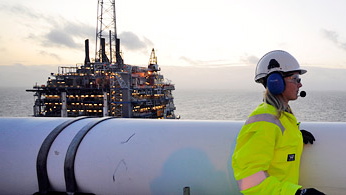Debate is running hot and heavy as Norway’s three-party government coalition faces yet another deadline for agreeing on how to cut carbon emissions. A climate pact has been delayed repeatedly because the government parties keep arguing, and now they’re under more pressure than ever.

All three government parties – Labour, the Socialist Left (SV) and the Center Party (Sp) – spout concern for the environment, and have actively supported emission cuts abroad. The problem is over how to cut emissions at home in Norway, where the country’s oil and gas industry and small population leave it with high rates of emissions on a per capita basis.
The government coalition struck a klimaforliket (literally, climate compromise) with the Parliament in 2008 that calls for Norway to cut its emissions by 30 percent by 2020. All the parties in Parliament with the exception of the most conservative among them, the Progress Party, supported the emission-cut goal.
It was left to the government to hash out where emissions would actually be cut. All agreed at the time that fully two thirds of Norway’s emission cuts – expected to equal around 17 million tons of carbon dioxide – would be made at home. But the three government parties have been arguing ever since over how and where within Norway the emission cuts would be demanded.

Neither Labour nor one of its biggest backers, the trade union federation LO, wants to do anything to hurt Norwegian industry and, thereby, threaten the jobs that industry, not just oil and gas, creates. LO boss Roar Flåthen has been actively campaigning against the goal that two-thirds of Norway’s emission cuts will be made within the country. Flåthen repeated to newspaper Dagens Næringsliv (DN) over the weekend that he thinks that’s unrealistic.
“The goal of two-thirds is a symbol without reality,” Flåthen told DN. He sent a letter last week to Norway’s new cabinet minister for the environment, Bård Solhjell of SV, Prime Minister Jens Stoltenberg of Labour and the leaders of SV and Sp where he lays out LO’s own demands for the long-delayed climate pact.
“The climate pact must be updated and realistic,” Flåthen said, claiming he now has support from all other union bosses in Norway. The costs of cutting emissions within Norway are much higher than expected when the compromise was reached in 2008. Norwegian industry, claims Flåthen, can’t afford to face tougher demands than their competitors outside Norway.
He thinks more emission cuts need to be made within the transport sector, by boosting public transit systems to further reduce use of private cars and providing incentives for more goods to be shipped by rail instead of trucks. Flåthen also promotes more use of renewable energy and more investment in reducing emissions cuts outside Norway.
The problem is that even the most strenuous measures on the average Norwegian to, for example, discourage car use, won’t add up to much in terms of actual cuts. Oil and gas and other industries would still need to make major cuts if the two current climate goals are to be met.
Tired of oil’s ‘bad guy’ image
Government officials from Stoltenberg to Oil and Energy Minster Ola Borten Moe of Sp, to those within SV who haven’t wanted to back down on the goals still claim a pact is in the works. Trine Skei Grande of the opposition Liberal Party (Venstre) told DN that the government spoiled its own chances of meeting its goals through all the delays since 2008. Other opposition politicians seem to support Flåthen and are tired of Norway’s oil and gas industry often being painted as the “bad guy” in the emissions debate. Norway serves both its own and global interests through its strong oil industry, wrote Morten Høglund of the Progress Party (Fremskrittspartiet, Frp) recently in a column in newspaper Aftenposten. He and Moe himself keep encouraging more oil exploration and development.
Torgeir Micaelsen of Labour, who heads the finance committee in Parliament, also recently said he’s tired of local opposition to the oil industry. All the griping about how Norway is too dependent on oil and how it hurts the environment “can make you think it’s a problem that we have an oil and gas industry,” Micaelsen told DN. He has no desire to put the brakes on the industry, another sign that brakes on the climate goals may be applied instead.
The government’s climate pact is due before summer, when many Norwegians will be flying off on summer holidays and, arguably, generating even more harmful emissions. Newspaper Dagsavisen reported over the weekend that government workers themselves are among the biggest climate offenders, as they travel on many allegedly unnecessary flights that also create emissions. The Foreign Ministry was ranked as the worst offender, followed by workers within foreign aid agency Norad and, in sixth place, the environmental ministry itself.
Views and News from Norway/Nina Berglund
Please support our stories by clicking on the “Donate” button now:

